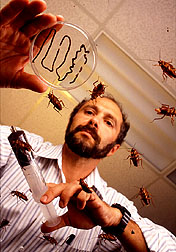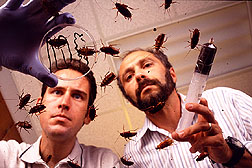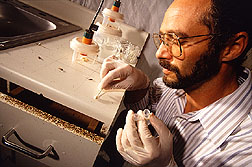Curbing Cockroaches and Their Allergens
In the fictional movie "Joe's Apartment," lead character Joe befriends thousands of cockroaches and learns to live in harmony with them. But in real life, anyone who has roaches tries to get rid of them.
Finding ways is Richard J. Brenner's primary goal. For more than a decade, the Agricultural Research Service entomologist at the Center for Medical, Agricultural, and Veterinary Entomology in Gainesville, Florida, has been working on innovative strategies and tools to send this ancient pest and the problems that come along with it packing.
"Cockroaches aren't just a social problem, they can also threaten health," says Brenner, who heads the center's Imported Fire Ant and Household Insects Research Unit.
Cockroaches may carry pathogenic organisms disease-causing bacteria and fungi that can be passed on to humans through surface and food contamination. Salmonella in food is one of the most common life-threatening pathogens that cockroaches can transmit to humans. But there are other, more likely, ways these pathogens are transmitted.
Health problems from cockroach-carried pathogens are largely circumstantial, but that is not the case with allergens. Brenner points out that cockroach feces, saliva, eggs, and outer covering, or cuticles, left behind on surfaces contain substances that are allergenic to humans, especially those with asthma or other respiratory conditions.
Not all cockroaches pose a threat. Of more than 4,000 species in the world, only a few dwell in homes. The German cockroach, Blattella germanicathe No.1 indoor insect and the brown-banded cockroach, Supella longipalpa, are the most troublesome species in the United States.
"Both species are strictly domestic and are therefore most commonly associated with humans and their structures," Brenner says.
Known in his field as the roach expert, Brenner and his colleagues have come up with a variety of tactics for combating the infamous insect from precision targeting, which relies on determining exactly where pests are and estimating their numbers, to allergen detection kits, to vacuum cleaners all aimed at reducing cockroach problems and related human health risks.
Brenner's team has confirmed the staying power of cockroach allergens. In the fall of 1990, the scientists infested an experimental kitchen with German cockroaches. They removed the roaches in February 1991. In 1996, they found cockroach allergens were still present.
This prompted Brenner and health care officials from the Arkansas Children's Hospital Research Institute in Little Rock, Arkansas, and the U.S. Food and Drug Administration (FDA) in Rockville, Maryland, to join forces under a memorandum of understanding to identify cockroach allergens and develop allergen detection technology.
"We're looking at how effective different interventions are at removing these allergens," says M. Christine Anderson, chief of FDA's Laboratory of Standards and Testing at the Center for Biologics Evaluation and Research. "We're planning to study two houses in Baltimore, Maryland, to see how effective cleaning is at removing allergens. We want to know if people actually feel better once the allergens have been removed."
Anderson says evaluating devices for effectiveness in removing cockroach allergens is important, because people particularly children may be allergic to more than one type.
"We are trying to detect all of the cockroach allergens that may potentially be a problem, not just one or two. This is the first time anyone has tried this approach," she says.
From this research, Brenner and fellow researchers have developed a cockroach allergen detection kit. The kit is sensitive, measuring as little as 150 cockroach-hour equivalents that is, the residue from six German cockroaches left on a 4-inch by 4-inch surface for 25 hours.
"This is a great tool, because before you can do anything, you have to know where the allergens are located," Anderson says.
Teamwork To Reduce Pesticides
It has become increasingly important, because of health and environmental concerns, to limit pesticide use. Brenner's group has several cooperative research and development agreements (CRADA) with other government agencies and commercial firms to develop reduced-pesticide-use technologies.
One of the biggest of these projects is a collaborative effort between the U.S. Department of Defense (DOD), Environmental Protection Agency (EPA), and Department of Energy to help DOD meet its pollution reduction requirements. It's called the Strategic Environmental Research and Development Program (SERDP).
"USDA and DOD have had a long-standing partnership of cooperative research in the area of pest management, going back more than 50 years," says U.S. Navy Captain Herbert T. Bolton. He is research liaison officer with DOD's Armed Forces Pest Management Board.
"This cooperative research partnership has allowed DOD to participate in customer focus workshops and has led to cooperative research on priority pest management issues of interest to DOD," Bolton says.
In 1995, DOD became a partner in EPA's Pesticide Environmental Stewardship Program and signed a memorandum of agreement with EPA to work toward reducing pesticide risk and use. This program was started in 1994 by EPA, USDA, and FDA to enlist public and private-sector cooperation in voluntarily reducing pesticide use.
"DOD has set internal goals of a 50-percent reduction in use of active ingredients--from the baseline, fiscal year 1993--by the year 2000," says Bolton. "We are also fully committed to implementing integrated pest management (IPM) practices in our pest management programs."
In 1996, Brenner's group submitted a 4-year research proposal titled "Pesticide Reduction Through Precision Targeting" to the SERDP committee. This responded to DOD's IPM research requirements: Develop a comprehensive, scientific system for reducing pesticide use while protecting troops, supplies and rations, facilities, and natural resources from disease vectors and pests.
"DOD's goal is to use targeted, effective, environmentally sound methods including education, habitat modification, biological and genetic control, cultural and mechanical control, and--where necessary--judicious use of least-hazardous pesticides," Bolton says. "The research efforts made by Brenner's group will help us accomplish this goal."
Some of Brenner's other cooperative research projects that are focused on tackling social and health implications of cockroaches include:
· A CRADA with Terminix International Co., of Memphis, Tennessee, to develop nontoxic strategies for eliminating cockroaches and their allergens. What came out of this partnership was a recently patented new tool. It consists of a vacuum device that uses hot, dry air to chase cockroaches from their hiding places and special disposable filters to capture them and their allergens. This nontoxic alternative will reduce the amount of pesticides applied by pest control services, which typically use chemical irritants to flush out cockroaches.
A CRADA with Colgate-Palmolive Co., in New York, New York, to develop strategies for eliminating or preventing cockroach infestations in buildings by using repellents and to enhance indoor environmental quality by reducing cockroach allergens.
Targeting the Problem
To cut down on allergens, scientists need to control the cockroaches themselves. This requires knowing exactly where they are.
Brenner has developed a computerized precision targeting system that determines the location and distribution of cockroaches based on trap counts and their positions. After entering trap data into the computer, scientists use spatial analysis to construct contour maps showing the population centers needing treatment.
Spatial statistical analysis is a procedure that characterizes the spatial relationships from trap data and then uses them to estimate values between trap points so the entire pest distribution can be determined. This technique helps reduce pesticide use by allowing the pest control operator to treat only pest-infested areas, rather than spraying broadly or fumigating an entire dwelling. It also facilitates development of IPM approaches that the pest control industry has been eager for.
"Usually, IPM requires a higher level of training and skill than is typical for normal pest control operations," says Brenner. "Most pest control operators typically focus on when and where they expect pests to be found. But things can change, such as how and where a person stores food or the addition of new hiding places for pests. Therefore, pests may be in unexpected areas where the pest control operator may not be looking."
Brenner says that precision targeting, unbiased as it is by previous observations, helps the pest control operator detect subtle changes in pest distributions. So "pest distribution can be determined consistently, regardless of the skill level of the technician," says Brenner.
The technique also allows the pest control operator to assess the efficacy of the treatments. And the process can be used to measure and spatially characterize possible risks to health associated with cockroaches, such as allergens.
Brenner says precision targeting has broader uses than uncovering where pests are infiltrating homes,
offices, and buildings. He says it can result in pesticide use reductions of 40 to 100 percent, depending on the pest and the control strategy. It could also save money by detecting infestation early, "when it's a $2 problem versus a $200 problem," says Brenner.
DOD plans to use the precision targeting software--still under development--and technologies in its pest control operations.
"This approach integrates a variety of reduced-risk technologies that will allow DOD to meet and exceed its pesticide-reduction mandate," says Brenner.
"Precision targeting will provide the documentation DOD needs," Bolton says. "It will provide contour maps of pest distributions and the attendant risks to health, supplies, and facilities; precise locations where we need interventions; a measure of post-intervention efficacy; and documentation of pesticide use reductions."
"But precision targeting's not a cure-all solution to the pesticide use problem," notes Brenner. "We won't get away from using some pesticides. Nevertheless, with it, we can use the least amount of pesticides and only when necessary.
"The idea of precision targeting is to shift emphasis from reactive strategies after the problem has been established to proactive pest management that prevents the problem."--By Tara Weaver, Agricultural Research Service Information Staff.
Richard J. Brenner is in the USDA-ARS Imported Fire Ant and Household Insects Research Unit, 1600 SW 23rd Dr., Gainesville, FL 32604; phone (352) 374-5855, fax (352) 374-5818.
"Curbing Cockroaches and Their Allergens " was published in the June 1998 issue of Agricultural Research magazine. Click here to see this issue's table of contents.









